An Examination of Elizabeth Freeman's Analysis of Marriage
VerifiedAdded on 2020/05/08
|6
|1169
|221
Essay
AI Summary
This essay analyzes Elizabeth Freeman's views on marriage, drawing from her personal diary and broader societal observations. Freeman views marriage as an institution, critiquing its role within American culture, particularly the conflicting functions it serves. The essay examines how Freeman challenges the U.S. cultural norms, highlighting the power dynamics, including patriarchy, and the impact on gender identity and sexual hierarchy. The analysis includes comparisons with Midwife Martha Ballard's Diary, exploring themes of courtship, community control, and the historical evolution of marriage as a legal and social construct. The essay also references various sources to support Freeman's perspectives, examining historical and societal influences on the institution of marriage and its impact on individuals. The essay explores the evolution of marriage and the cultural implications of societal expectations and the impact on gender roles and power dynamics, with a focus on the historical and cultural implications of marriage.
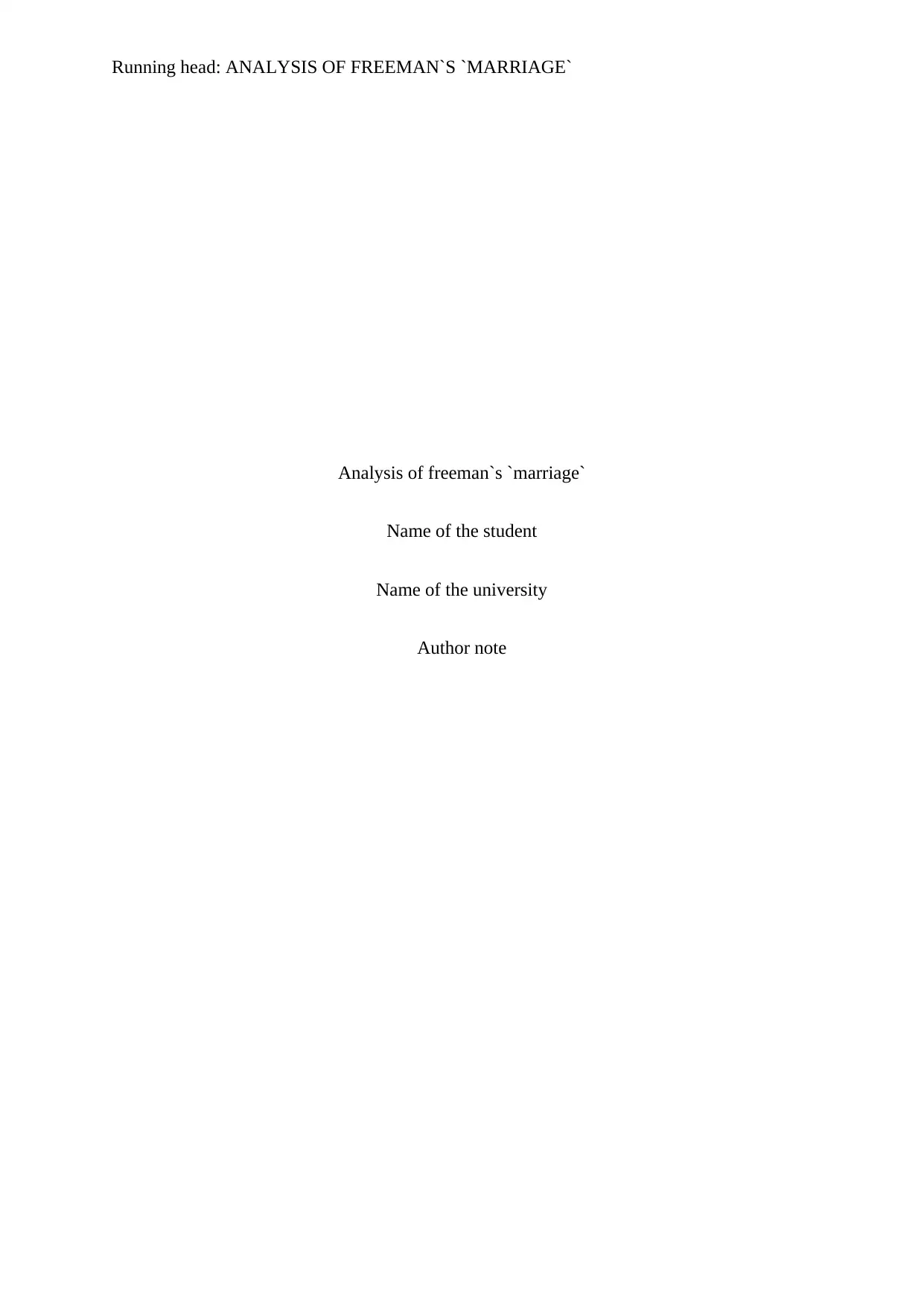
Running head: ANALYSIS OF FREEMAN`S `MARRIAGE`
Analysis of freeman`s `marriage`
Name of the student
Name of the university
Author note
Analysis of freeman`s `marriage`
Name of the student
Name of the university
Author note
Paraphrase This Document
Need a fresh take? Get an instant paraphrase of this document with our AI Paraphraser
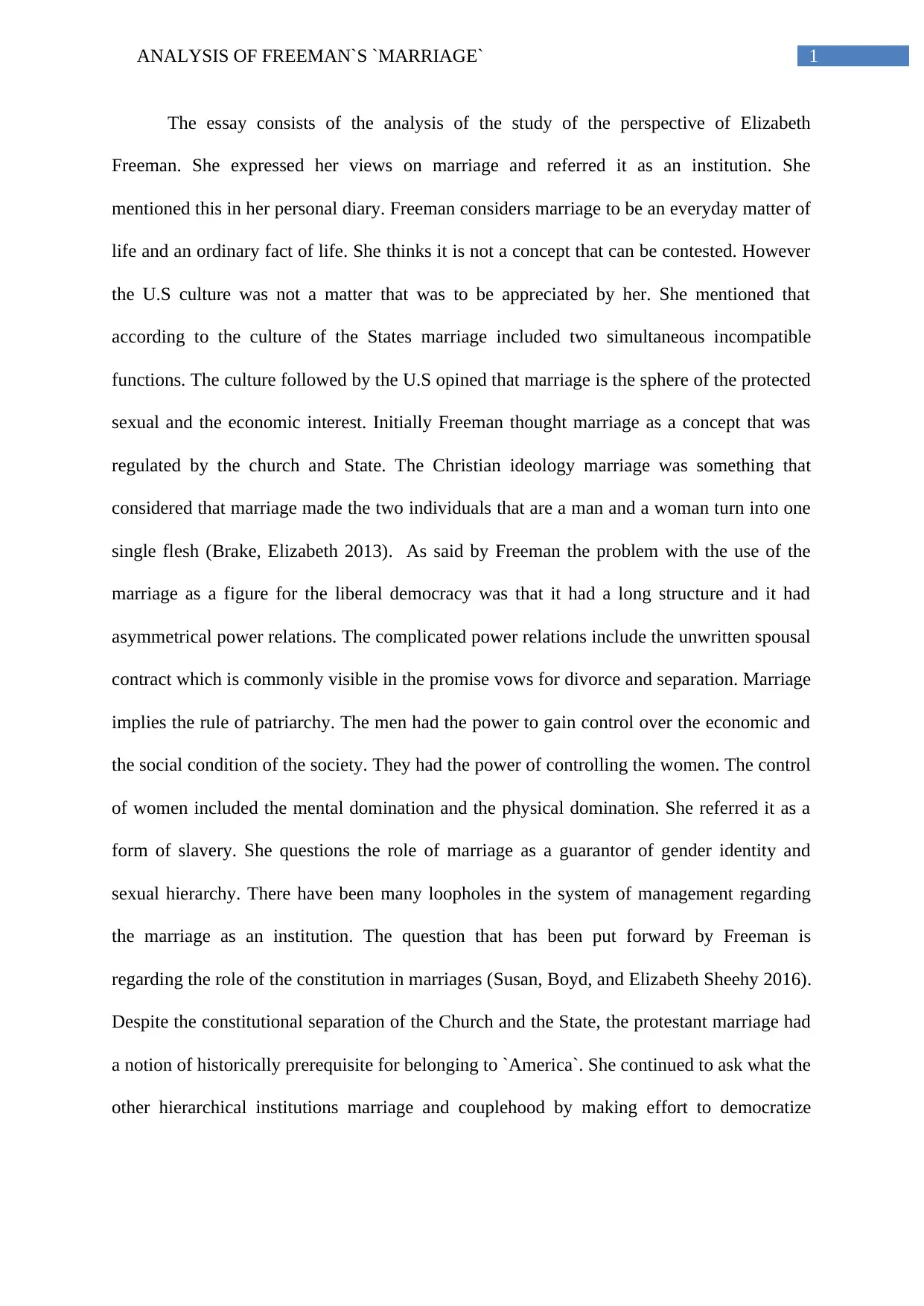
1ANALYSIS OF FREEMAN`S `MARRIAGE`
The essay consists of the analysis of the study of the perspective of Elizabeth
Freeman. She expressed her views on marriage and referred it as an institution. She
mentioned this in her personal diary. Freeman considers marriage to be an everyday matter of
life and an ordinary fact of life. She thinks it is not a concept that can be contested. However
the U.S culture was not a matter that was to be appreciated by her. She mentioned that
according to the culture of the States marriage included two simultaneous incompatible
functions. The culture followed by the U.S opined that marriage is the sphere of the protected
sexual and the economic interest. Initially Freeman thought marriage as a concept that was
regulated by the church and State. The Christian ideology marriage was something that
considered that marriage made the two individuals that are a man and a woman turn into one
single flesh (Brake, Elizabeth 2013). As said by Freeman the problem with the use of the
marriage as a figure for the liberal democracy was that it had a long structure and it had
asymmetrical power relations. The complicated power relations include the unwritten spousal
contract which is commonly visible in the promise vows for divorce and separation. Marriage
implies the rule of patriarchy. The men had the power to gain control over the economic and
the social condition of the society. They had the power of controlling the women. The control
of women included the mental domination and the physical domination. She referred it as a
form of slavery. She questions the role of marriage as a guarantor of gender identity and
sexual hierarchy. There have been many loopholes in the system of management regarding
the marriage as an institution. The question that has been put forward by Freeman is
regarding the role of the constitution in marriages (Susan, Boyd, and Elizabeth Sheehy 2016).
Despite the constitutional separation of the Church and the State, the protestant marriage had
a notion of historically prerequisite for belonging to `America`. She continued to ask what the
other hierarchical institutions marriage and couplehood by making effort to democratize
The essay consists of the analysis of the study of the perspective of Elizabeth
Freeman. She expressed her views on marriage and referred it as an institution. She
mentioned this in her personal diary. Freeman considers marriage to be an everyday matter of
life and an ordinary fact of life. She thinks it is not a concept that can be contested. However
the U.S culture was not a matter that was to be appreciated by her. She mentioned that
according to the culture of the States marriage included two simultaneous incompatible
functions. The culture followed by the U.S opined that marriage is the sphere of the protected
sexual and the economic interest. Initially Freeman thought marriage as a concept that was
regulated by the church and State. The Christian ideology marriage was something that
considered that marriage made the two individuals that are a man and a woman turn into one
single flesh (Brake, Elizabeth 2013). As said by Freeman the problem with the use of the
marriage as a figure for the liberal democracy was that it had a long structure and it had
asymmetrical power relations. The complicated power relations include the unwritten spousal
contract which is commonly visible in the promise vows for divorce and separation. Marriage
implies the rule of patriarchy. The men had the power to gain control over the economic and
the social condition of the society. They had the power of controlling the women. The control
of women included the mental domination and the physical domination. She referred it as a
form of slavery. She questions the role of marriage as a guarantor of gender identity and
sexual hierarchy. There have been many loopholes in the system of management regarding
the marriage as an institution. The question that has been put forward by Freeman is
regarding the role of the constitution in marriages (Susan, Boyd, and Elizabeth Sheehy 2016).
Despite the constitutional separation of the Church and the State, the protestant marriage had
a notion of historically prerequisite for belonging to `America`. She continued to ask what the
other hierarchical institutions marriage and couplehood by making effort to democratize
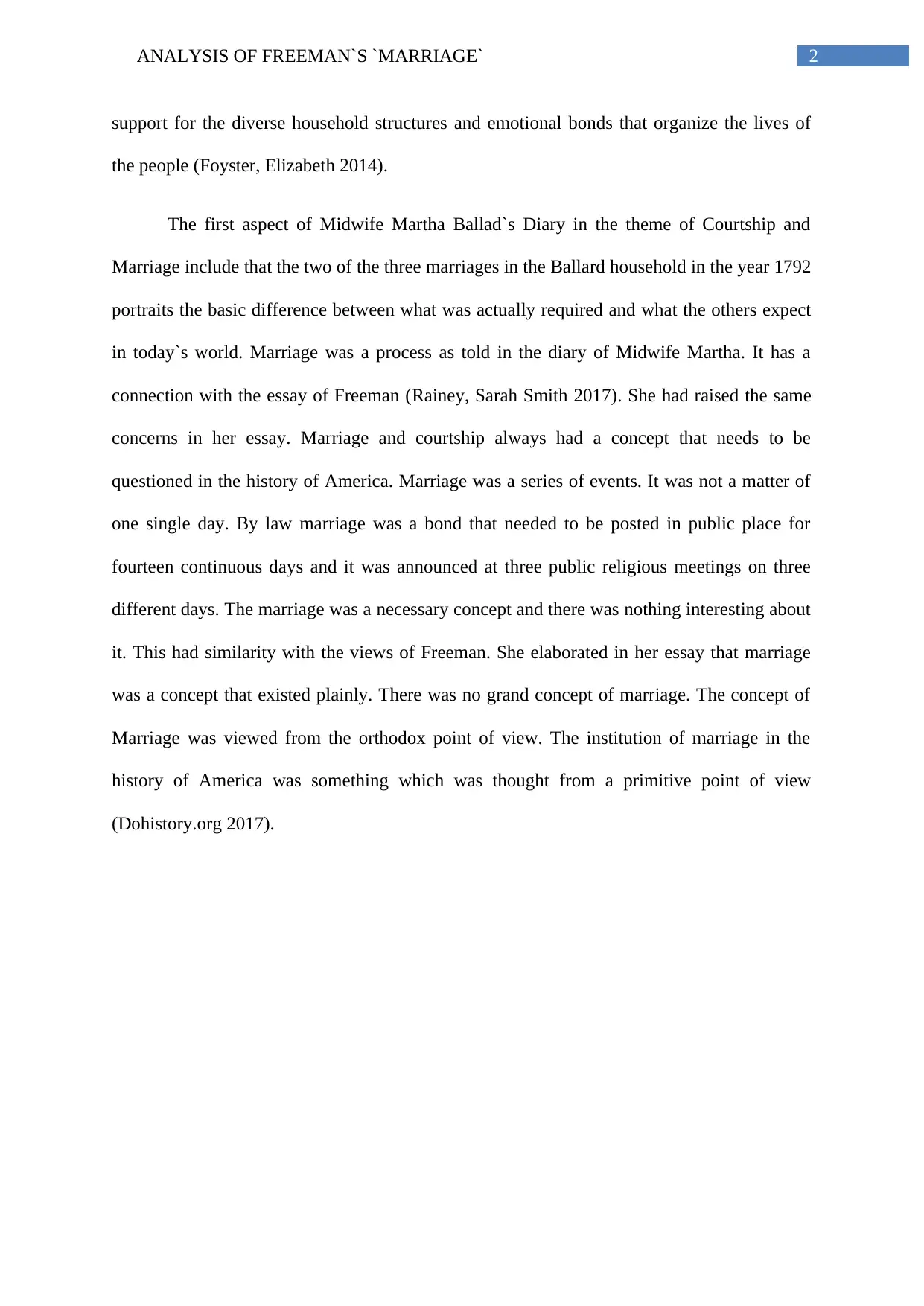
2ANALYSIS OF FREEMAN`S `MARRIAGE`
support for the diverse household structures and emotional bonds that organize the lives of
the people (Foyster, Elizabeth 2014).
The first aspect of Midwife Martha Ballad`s Diary in the theme of Courtship and
Marriage include that the two of the three marriages in the Ballard household in the year 1792
portraits the basic difference between what was actually required and what the others expect
in today`s world. Marriage was a process as told in the diary of Midwife Martha. It has a
connection with the essay of Freeman (Rainey, Sarah Smith 2017). She had raised the same
concerns in her essay. Marriage and courtship always had a concept that needs to be
questioned in the history of America. Marriage was a series of events. It was not a matter of
one single day. By law marriage was a bond that needed to be posted in public place for
fourteen continuous days and it was announced at three public religious meetings on three
different days. The marriage was a necessary concept and there was nothing interesting about
it. This had similarity with the views of Freeman. She elaborated in her essay that marriage
was a concept that existed plainly. There was no grand concept of marriage. The concept of
Marriage was viewed from the orthodox point of view. The institution of marriage in the
history of America was something which was thought from a primitive point of view
(Dohistory.org 2017).
support for the diverse household structures and emotional bonds that organize the lives of
the people (Foyster, Elizabeth 2014).
The first aspect of Midwife Martha Ballad`s Diary in the theme of Courtship and
Marriage include that the two of the three marriages in the Ballard household in the year 1792
portraits the basic difference between what was actually required and what the others expect
in today`s world. Marriage was a process as told in the diary of Midwife Martha. It has a
connection with the essay of Freeman (Rainey, Sarah Smith 2017). She had raised the same
concerns in her essay. Marriage and courtship always had a concept that needs to be
questioned in the history of America. Marriage was a series of events. It was not a matter of
one single day. By law marriage was a bond that needed to be posted in public place for
fourteen continuous days and it was announced at three public religious meetings on three
different days. The marriage was a necessary concept and there was nothing interesting about
it. This had similarity with the views of Freeman. She elaborated in her essay that marriage
was a concept that existed plainly. There was no grand concept of marriage. The concept of
Marriage was viewed from the orthodox point of view. The institution of marriage in the
history of America was something which was thought from a primitive point of view
(Dohistory.org 2017).
⊘ This is a preview!⊘
Do you want full access?
Subscribe today to unlock all pages.

Trusted by 1+ million students worldwide
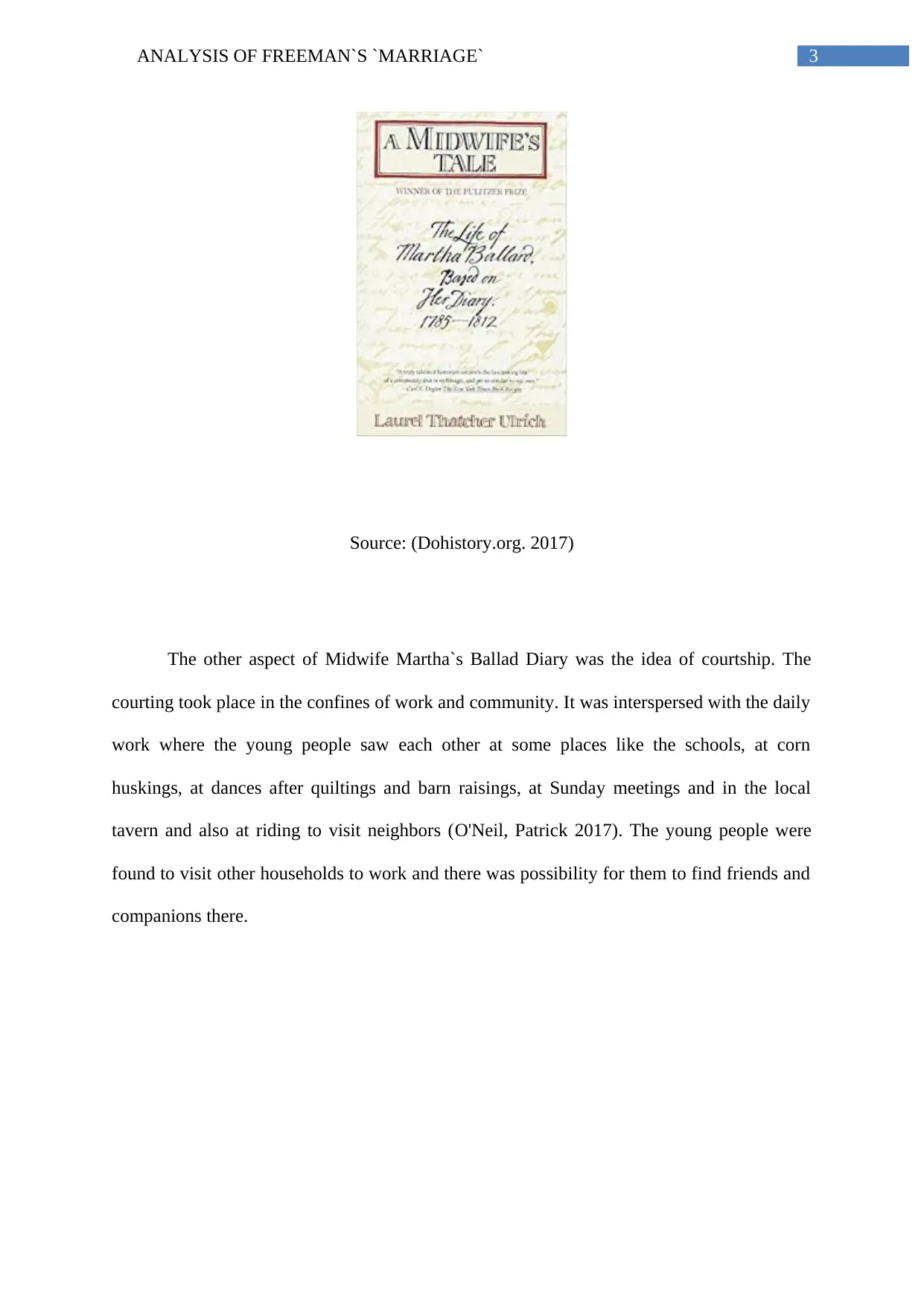
3ANALYSIS OF FREEMAN`S `MARRIAGE`
Source: (Dohistory.org. 2017)
The other aspect of Midwife Martha`s Ballad Diary was the idea of courtship. The
courting took place in the confines of work and community. It was interspersed with the daily
work where the young people saw each other at some places like the schools, at corn
huskings, at dances after quiltings and barn raisings, at Sunday meetings and in the local
tavern and also at riding to visit neighbors (O'Neil, Patrick 2017). The young people were
found to visit other households to work and there was possibility for them to find friends and
companions there.
Source: (Dohistory.org. 2017)
The other aspect of Midwife Martha`s Ballad Diary was the idea of courtship. The
courting took place in the confines of work and community. It was interspersed with the daily
work where the young people saw each other at some places like the schools, at corn
huskings, at dances after quiltings and barn raisings, at Sunday meetings and in the local
tavern and also at riding to visit neighbors (O'Neil, Patrick 2017). The young people were
found to visit other households to work and there was possibility for them to find friends and
companions there.
Paraphrase This Document
Need a fresh take? Get an instant paraphrase of this document with our AI Paraphraser
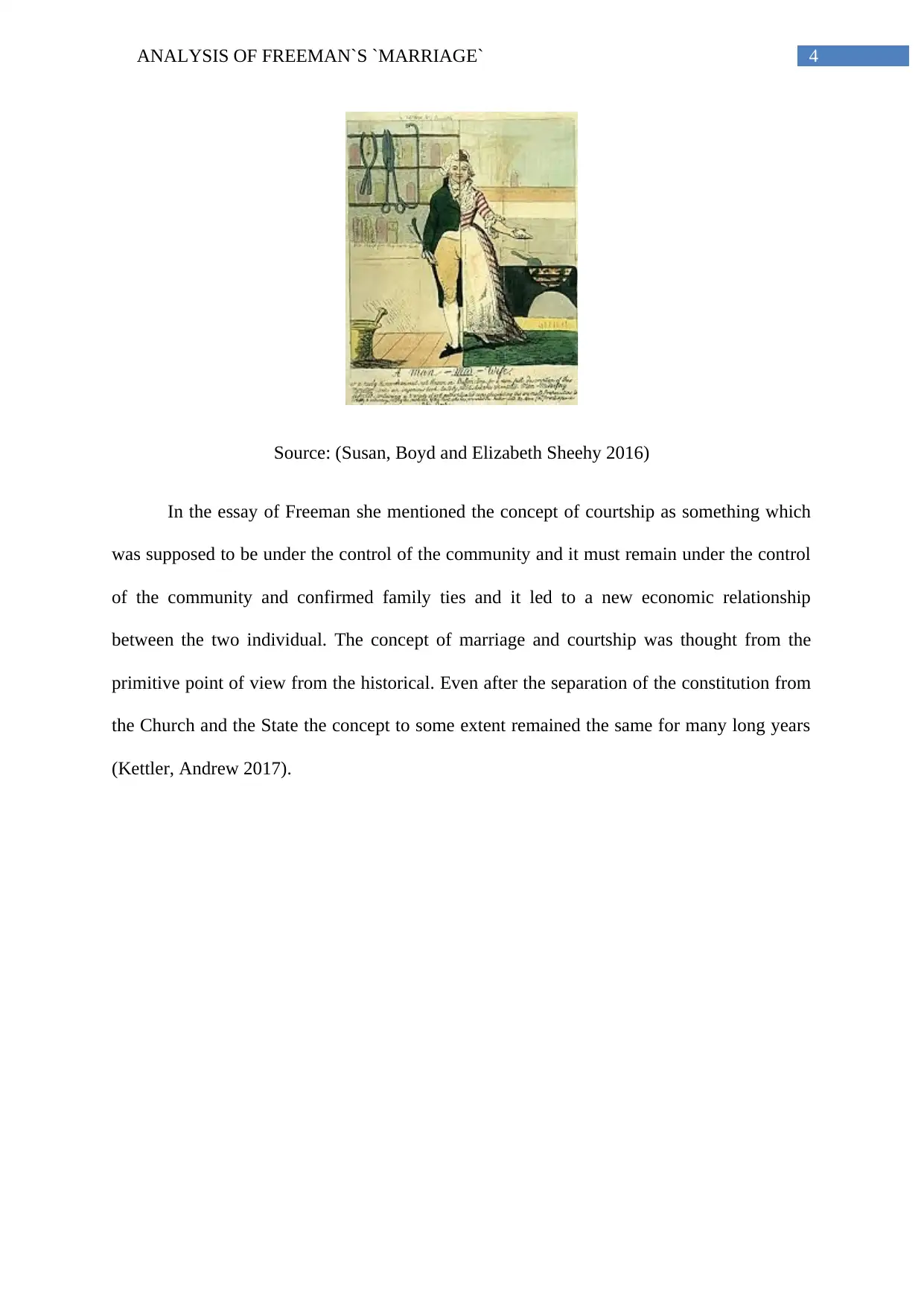
4ANALYSIS OF FREEMAN`S `MARRIAGE`
Source: (Susan, Boyd and Elizabeth Sheehy 2016)
In the essay of Freeman she mentioned the concept of courtship as something which
was supposed to be under the control of the community and it must remain under the control
of the community and confirmed family ties and it led to a new economic relationship
between the two individual. The concept of marriage and courtship was thought from the
primitive point of view from the historical. Even after the separation of the constitution from
the Church and the State the concept to some extent remained the same for many long years
(Kettler, Andrew 2017).
Source: (Susan, Boyd and Elizabeth Sheehy 2016)
In the essay of Freeman she mentioned the concept of courtship as something which
was supposed to be under the control of the community and it must remain under the control
of the community and confirmed family ties and it led to a new economic relationship
between the two individual. The concept of marriage and courtship was thought from the
primitive point of view from the historical. Even after the separation of the constitution from
the Church and the State the concept to some extent remained the same for many long years
(Kettler, Andrew 2017).
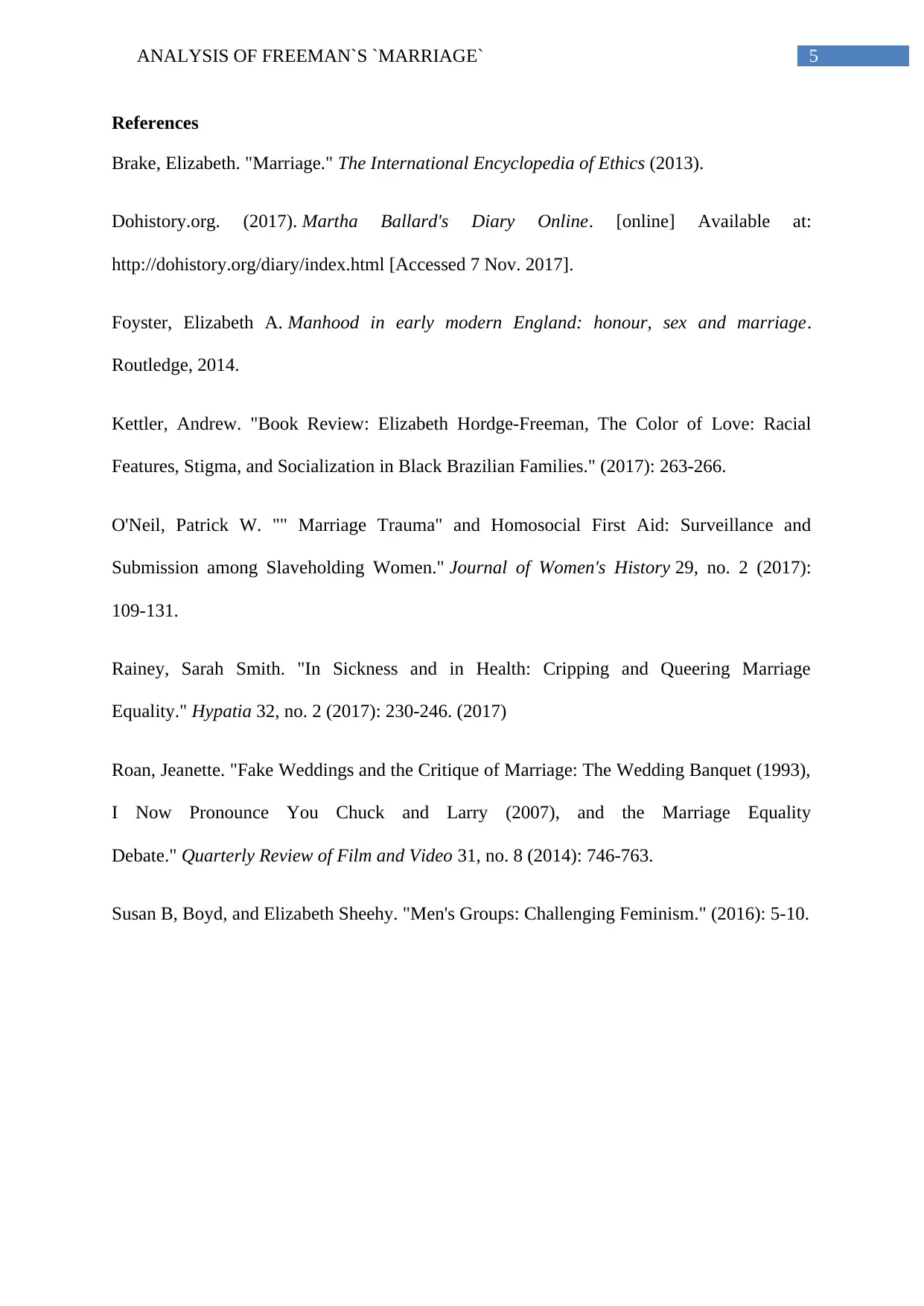
5ANALYSIS OF FREEMAN`S `MARRIAGE`
References
Brake, Elizabeth. "Marriage." The International Encyclopedia of Ethics (2013).
Dohistory.org. (2017). Martha Ballard's Diary Online. [online] Available at:
http://dohistory.org/diary/index.html [Accessed 7 Nov. 2017].
Foyster, Elizabeth A. Manhood in early modern England: honour, sex and marriage.
Routledge, 2014.
Kettler, Andrew. "Book Review: Elizabeth Hordge-Freeman, The Color of Love: Racial
Features, Stigma, and Socialization in Black Brazilian Families." (2017): 263-266.
O'Neil, Patrick W. "" Marriage Trauma" and Homosocial First Aid: Surveillance and
Submission among Slaveholding Women." Journal of Women's History 29, no. 2 (2017):
109-131.
Rainey, Sarah Smith. "In Sickness and in Health: Cripping and Queering Marriage
Equality." Hypatia 32, no. 2 (2017): 230-246. (2017)
Roan, Jeanette. "Fake Weddings and the Critique of Marriage: The Wedding Banquet (1993),
I Now Pronounce You Chuck and Larry (2007), and the Marriage Equality
Debate." Quarterly Review of Film and Video 31, no. 8 (2014): 746-763.
Susan B, Boyd, and Elizabeth Sheehy. "Men's Groups: Challenging Feminism." (2016): 5-10.
References
Brake, Elizabeth. "Marriage." The International Encyclopedia of Ethics (2013).
Dohistory.org. (2017). Martha Ballard's Diary Online. [online] Available at:
http://dohistory.org/diary/index.html [Accessed 7 Nov. 2017].
Foyster, Elizabeth A. Manhood in early modern England: honour, sex and marriage.
Routledge, 2014.
Kettler, Andrew. "Book Review: Elizabeth Hordge-Freeman, The Color of Love: Racial
Features, Stigma, and Socialization in Black Brazilian Families." (2017): 263-266.
O'Neil, Patrick W. "" Marriage Trauma" and Homosocial First Aid: Surveillance and
Submission among Slaveholding Women." Journal of Women's History 29, no. 2 (2017):
109-131.
Rainey, Sarah Smith. "In Sickness and in Health: Cripping and Queering Marriage
Equality." Hypatia 32, no. 2 (2017): 230-246. (2017)
Roan, Jeanette. "Fake Weddings and the Critique of Marriage: The Wedding Banquet (1993),
I Now Pronounce You Chuck and Larry (2007), and the Marriage Equality
Debate." Quarterly Review of Film and Video 31, no. 8 (2014): 746-763.
Susan B, Boyd, and Elizabeth Sheehy. "Men's Groups: Challenging Feminism." (2016): 5-10.
⊘ This is a preview!⊘
Do you want full access?
Subscribe today to unlock all pages.

Trusted by 1+ million students worldwide
1 out of 6
Your All-in-One AI-Powered Toolkit for Academic Success.
+13062052269
info@desklib.com
Available 24*7 on WhatsApp / Email
![[object Object]](/_next/static/media/star-bottom.7253800d.svg)
Unlock your academic potential
Copyright © 2020–2025 A2Z Services. All Rights Reserved. Developed and managed by ZUCOL.